|
Collective Self-esteem
Collective self-esteem is a concept originating in the field of psychology that describes the aspect of an individual's self-image that stems from how the individual interacts with others and the groups that the individual is a part of. The idea originated during the research of Jennifer Crocker, during which she was trying to learn about the connection between a person's self-esteem and their attitude towards or about the group that the person is part of. Collective self-esteem is talked about subjectively as a concept as well as measured objectively with various scales and assessments. The data from such research is used practically to give importance and weight to the idea that most individuals benefit from being in a group setting for at least sometime as well as being able to identify with being a part of a group. Or not. History Jennifer Crocker and Riia Luhtanen were the first to study collective self-esteem. They believed there was a relationship between people's self-es ... [...More Info...] [...Related Items...] OR: [Wikipedia] [Google] [Baidu] |
Self-image
Self-image is the mental picture, generally of a kind that is quite resistant to change, that depicts not only details that are potentially available to an objective investigation by others (height, weight, hair color, etc.), but also items that have been learned by persons about themselves, either from personal experiences or by internalizing the judgments of others. Self-image may consist of six types: # Self-image resulting from how an individual sees oneself. # Self-image resulting from how others see the individual. # Self-image resulting from how the individual perceives the individual sees oneself. # Self-image resulting from how the individual perceives how others see the individual. # Self-image resulting from how others perceive how the individual sees oneself. # Self-image resulting from how others perceive how others see the individual. These six types may or may not be an accurate representation of the person. All, some, or none of them may be true. A more technical ... [...More Info...] [...Related Items...] OR: [Wikipedia] [Google] [Baidu] |
Jennifer Crocker
Dr. Jennifer Crocker is a professor and Ohio Eminent Scholar in Social Psychology at Ohio State University. She is also a former president of the Society for Personality and Social Psychology. Her publications are on the subject of self-esteem and the contingencies and interpersonal goals that individuals have that are a clear reflection of their level of self-esteem. Career She received her BA in psychology from Michigan State University, and her Ph.D. in Psychology and Social Relations from Harvard University in 1979 with a thesis on "Schemas, hypothesis-testing, and intuitive assessments of covariation" She was subsequently assistant professor of psychology at Northwestern University(1979-1985), Professor at the University of Buffalo (1985-1995), Research Professor at the Institute for Social Research and Claude Steele Collegiate Professor of psychology at the University of Michigan (1995-2010). She came to Ohio State in June 2010. Awards She is a Fello ... [...More Info...] [...Related Items...] OR: [Wikipedia] [Google] [Baidu] |
Self-esteem
Self-esteem is confidence in one's own worth or abilities. Self-esteem encompasses beliefs about oneself (for example, "I am loved", "I am worthy") as well as emotional states, such as triumph, despair, pride, and shame. Smith and Mackie (2007) defined it by saying "The self-concept is what we think about the self; self-esteem, is the positive or negative evaluations of the self, as in how we feel about it." Self-esteem is an attractive psychological construct because it predicts certain outcomes, such as academic achievement, happiness, satisfaction in marriage and relationships, and criminal behavior. Self-esteem can apply to a specific attribute or globally. Psychologists usually regard self-esteem as an enduring personality characteristic (''trait self-esteem''), though normal, short-term variations (''state self-esteem'') also exist. Synonyms or near-synonyms of self-esteem include: self-worth, self-regard, self-respect, and self-integrity. History The concept of self-est ... [...More Info...] [...Related Items...] OR: [Wikipedia] [Google] [Baidu] |
Ingroups And Outgroups
In sociology and social psychology, an in-group is a social group to which a person psychologically identifies as being a member. By contrast, an out-group is a social group with which an individual does not identify. People may for example identify with their peer group, family, community, sports team, political party, gender, sexual orientation, religion, or nation. It has been found that the psychological membership of social groups and categories is associated with a wide variety of phenomena. The terminology was made popular by Henri Tajfel and colleagues beginning in the 1970s during his work in formulating social identity theory. The significance of in-group and out-group categorization was identified using a method called the minimal group paradigm. Tajfel and colleagues found that people can form self-preferencing in-groups within a matter of minutes and that such groups can form even on the basis of completely arbitrary and invented discriminatory characteristics, su ... [...More Info...] [...Related Items...] OR: [Wikipedia] [Google] [Baidu] |
Social Identity Theory
Social identity is the portion of an individual's self-concept derived from perceived membership in a relevant social group. As originally formulated by social psychologists Henri Tajfel and John Turner in the 1970s and the 1980s, social identity theory introduced the concept of a social identity as a way in which to explain intergroup behaviour. "Social identity theory explores the phenomenon of the 'ingroup' and 'outgroup', and is based on the view that identities are constituted through a process of difference defined in a relative or flexible way depends on the activities in which one engages" This theory is described as a theory that predicts certain intergroup behaviours on the basis of perceived group status differences, the perceived legitimacy and stability of those status differences, and the perceived ability to move from one group to another. This contrasts with occasions where the term "social identity theory" is used to refer to general theorizing about hum ... [...More Info...] [...Related Items...] OR: [Wikipedia] [Google] [Baidu] |
Basking In Reflected Glory
Basking in reflected glory (BIRGing) is a self-serving cognition whereby an individual associates themselves with known successful others such that the winner's success becomes the individual's own accomplishment. The affiliation of another's success is enough to stimulate self glory. The individual does not need to be personally involved in the successful action. To BIRG, they must simply associate themselves with the success. Examples of BIRGing include anything from sharing a home state with a past or present famous person, to religious affiliations, to sports teams. For example, when a fan of a football team wears the team's jersey and boasts after a win, this fan is engaging in BIRGing. A parent with a bumper sticker reading "My child is an honor student" is basking in the reflected glory of their child. While many people have anecdotal accounts of BIRGing, social psychologists seek to find experimental investigations delving into BIRGing. Within social psychology, BIRGin ... [...More Info...] [...Related Items...] OR: [Wikipedia] [Google] [Baidu] |
In-group Favoritism
In-group favoritism, sometimes known as in-group–out-group bias, in-group bias, intergroup bias, or in-group preference, is a pattern of favoring members of one's in-group over out-group members. This can be expressed in evaluation of others, in allocation of resources, and in many other ways.Aronson, E., Wilson, T. D., & Akert, R. (2010). ''Social psychology''. 7th ed. Upper Saddle River: Prentice Hall. This effect has been researched by many psychologists and linked to many theories related to group conflict and prejudice. The phenomenon is primarily viewed from a social psychology standpoint. Studies have shown that in-group favoritism arises as a result of the formation of cultural groups. These cultural groups can be divided based on seemingly trivial observable traits, but with time, populations grow to associate certain traits with certain behavior, increasing covariation. This then incentivizes in-group bias. Two prominent theoretical approaches to the phenomenon of ... [...More Info...] [...Related Items...] OR: [Wikipedia] [Google] [Baidu] |
Social Identity Theory
Social identity is the portion of an individual's self-concept derived from perceived membership in a relevant social group. As originally formulated by social psychologists Henri Tajfel and John Turner in the 1970s and the 1980s, social identity theory introduced the concept of a social identity as a way in which to explain intergroup behaviour. "Social identity theory explores the phenomenon of the 'ingroup' and 'outgroup', and is based on the view that identities are constituted through a process of difference defined in a relative or flexible way depends on the activities in which one engages" This theory is described as a theory that predicts certain intergroup behaviours on the basis of perceived group status differences, the perceived legitimacy and stability of those status differences, and the perceived ability to move from one group to another. This contrasts with occasions where the term "social identity theory" is used to refer to general theorizing about hum ... [...More Info...] [...Related Items...] OR: [Wikipedia] [Google] [Baidu] |


